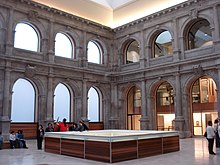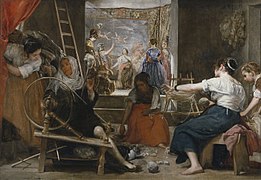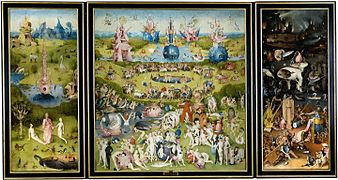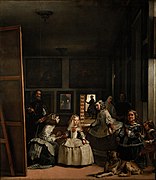Museo del Prado
The Museo del Prado in Madrid , Spain , called Prado for short ( Spanish prado "meadow"), is one of the largest and most important art museums in the world. In 2011 it counted around 2.9 million visitors.
Originally the Prado was founded as a picture gallery and glyptotheque , today the museum also includes over 5000 drawings, 2000 prints, 1000 coins and medals and almost 2000 other art objects. The sculpture collection has more than 700 objects and other fragments. It is one of the most important museums in the world. In addition to the world's best collection of Spanish painters, Dutch masters and some works by Botticelli , Caravaggio , Albrecht Dürer and Rembrandt are also on display.
history
Foundation and collection history

Ferdinand VII wanted to create a picture gallery based on the model of the Louvre in 1815 . In 1818 the premises for a new museum were finally found, which was owned by Charles III. created building of the Royal Museum of Natural Sciences in the Prado de San Jerónimo 'Meadow of Saint Jerome'. It was built between 1785 and 1808 by the architect Juan de Villanueva and renovated by Antonio López Aguado for its new purpose from 1818.
On November 19, 1819, the Museo del Prado was inaugurated under the name Museo Real de Pintura y Escultura 'Royal Museum of Painting and Sculpture'. The collections of the Museo de la Trinidad 'Trinity Museum ' are added to the Prado in 1872. During the siege of Madrid by the Franquists , the Prado was bombed on November 16, 1936 by the German and Italian air forces. The artists and cultural politician Josep Renau had the works of art in the of the Spanish Republic held Valencia evacuated. From 1971 the works of the 19th and 20th centuries were outsourced to the Museo Reina Sofía (inaugurated in 1992, replaced the Museo Español de Arte Contemporáneo, MEAC for short).
extension
The trigger for a renewal of the outdated museum was the spectacular renovation of the Louvre that began in 1989 . A first architectural competition failed due to disagreement for the winning design. After a second competition in 1997, the Pritzker Prize winner Rafael Moneo was awarded the contract for an extension behind the Prado. In 2002, however, residents filed a lawsuit against the building, fearing for their tranquility, but officially citing reasons for monument conservation. The baroque cloister of the adjoining Jerónimo monastery, which had already been shot down by the Napoleonic troops, had been falling apart for decades. In the extension building, the cloister has now been removed stone by stone, restored and roofed over. Today, some sculptures are placed between the balustrades . After a further delay in 2005, the extension was finally opened in October 2007. An underground passage connects both buildings. This increases the exhibition area by more than half. There is now a conference room for 400 people, a new painting depot and a new library. The cost was around 152 million euros - six times as much as originally estimated.
Cooperation with Google
At the beginning of 2009, the Internet company Google LLC, in cooperation with the Prado, put fourteen masterpieces online, which can be viewed online in extremely high resolution using the Google Earth program . The high-resolution images are available under commons: Category: Prado in Google Earth .
On November 19, 2019, Google honored the art museum on the occasion of its 200th anniversary with a Google Doodle .
collection
Spanish painting
With almost 4,900 works, the Spanish painting department is not only the most complete in the museum, but also the most important collection of this school in the world. Chronologically, it ranges from Romanesque wall paintings from the 12th century to the early 20th century. The collection includes Gothic paintings, from anonymous masters to authors such as Juan Rodríguez de Toledo, Nicolás Francés, Pedro Berruguete and the Spanish-Flemish Diego de la Cruz, Juan de Flandes and Fernando Gallego, as well as Jaume Serra in the area of the Crown of Aragon. Lluís Borrassà , Jaume Huguet , Pere Lembrí, Miguel Ximénez, Bartolomé Bermejo , Martin Bernat, Rodrigo and Francisco de Osona, Joan Reixach or Jacomart. The Spanish Renaissance, represented by Pedro Machuca , Alonso Berruguete , Juan de Juanes, Fernando Yáñez de la Almedina or Juan Correa de Vivar , and Mannerism with Luis de Morales , Blas de Prado and the absolute protagonism El Greco , of which the greatest Group of works is on display, including some of his most relevant works.
The time of the greatest brilliance of Spanish painting, the Baroque , is represented by Francisco de Zurbarán , José de Ribera , Bartolomé Esteban Murillo , Juan de Valdés Leal , Juan Bautista Maíno , Alonso Cano , Juan Carreño de Miranda , Francisco Ribalta , José Antolínez Antonio de Pereda , Francisco Rizi , Francisco de Herrera el Mozo, Juan Sánchez Cotán , Claudio Coello and above all the great master of Hispanic painting: Diego Velázquez .
From the 18th century onwards, Francisco de Goya's extensive collection stood out, comprising a total of one hundred and thirty- two paintings from all eras and facets of his art.
Italian painting
The collection of Italian painting consists of more than a thousand works and is undoubtedly one of the main attractions of the museum, even if it has some gaps, especially when it comes to works before the 16th century . Despite the fact that Italian literature had a great influence on Spain in the time of John II of Castile , novelties in the visual arts came later and their presence was very small until the 16th century. This was in large part due to the king and his daughter Isabel la Católica's fondness for Flemish painting and is also the reason why the museum's collection of primitive Italians is small.
Although the museum's collection offers a limited overview of Italian art prior to 1500, it does have masterpieces from that period. In addition to the masterpieces by Andrea Mantegna , Sandro Botticelli and the Christ by Antonello da Messina acquired in 1965, the three works by Fra Angelico are probably the most valuable set: it is a small predella of an altarpiece dedicated to the life of San Antonio , and two of his masterpieces, La Anunciación and La Virgen de la Granada. The incorporation of the latter in 2016 strengthened the work group of the Italian Quattrocento in particular .
The Cinquecento painting marks the beginning of the great period of Italian painting in the Prado with major works by Raphael and his workshop, in particular Giulio Romano and Giovanni Francesco Penni .
The museum is one of the institutions with the largest number of paintings from the last years of production of the master, including relevant works such as La Virgen del Pez , El pasmo de Sicilia or the Holy Family with Saint John, called «La perla» by Philip IV . who considered it the most valuable painting in his collection.
Particularly noteworthy is the Venetian painting from the 16th century, which represents the best collection outside of Italy. The school's central artist, Titian , was Charles V and Philip II's favorite painter , although some of his works are kept in the El Escorial monastery palace , the Prado has thirty of his paintings. He created some of his masterpieces for the first Habsburgs , such as the equestrian portrait of Charles V in Mühlberg or poetry. Also represented in the collection are Jacopo Tintoretto , Paolo Veronese , Lorenzo Lotto , Bonifazio Veronese , Jacopo Palma the Younger , Giovanni Battista Moroni , Bernardino Licinio, Jacopo Bassano and the sons Francesco and Leandro as well as some precursors such as Vincenzo Catena .
Italian baroque painting is one of the most compact cores of the Prado due to the diversity of artists and the quality of the works. The tenebrist and the Bolognese school are represented, which tenebrist with the initiator Caravaggio (David, Goliath wins) and his followers as Orazio Gentileschi (Moses, who was rescued from the water), his daughter Artemisia Gentileschi , Giovanni Battista Caracciolo (known as Battistello), Giovanni Serodine or Bernardo Cavallino . The Bolognese School is represented by paintings by Annibale Carracci (Venus, Adonis and Cupido, Asunción de María), Domenichino , Guido Ren i (Hipómenes and Atalanta), Giovanni Francesco Barbieri: Guercino , Giulio Cesare Procaccini, Alessandro Turchi and Giovanni Lanfranco .
Decorative Baroque has a unique example through the work of Pietro da Cortona (The Nativity, to whose support he used a vitreous paste called aventurine) and the excellent group of works by Luca Giordano , who worked for King Charles II . Further examples of other important Baroque authors are Francesco Furini , Salvatore Rosa , Orazio Borgianni, Michelangelo Cerquozzi , Mattia Preti , Andrea Sacchi , Carlo Maratta , Massimo Stanzione , Andrea Vaccaro , Bernardo Strozzi or Alessandro Magnasco .
The figure of Giambattista Tiepolo closes the chapter of Italian painting in the Prado. Tiepolo came to Spain with other artists to decorate the new royal palace in Madrid, such as his son Giandomenico Tiepolo and Corrado Giaquinto .
Flemish painting
In third place is Flemish painting, both in quantitative (more than a thousand works) and qualitative terms, only behind the Spanish and almost on an Italian level. On the one hand, it includes representatives of old Dutch painting , such as Robert Campin (with four of the twenty or so works attributed to him), Rogier van der Weyden ( Descent from the Cross , Madonna Durán), Dierick Bouts , Petrus Christ and Hans Memling (Triptych of the Adoration of the Magi). The museum also shows the best Hironymus Bosch collection in the world, with three of his major works: the triptychs The Garden of Earthly Delights , The Hay Wagon and The Adoration of the Magi . They come from the personal collection of Felipe II.
Exhibited masters (selection)
Sandro Botticelli : Scene from Boccaccio's »Decameron« 1487
Hieronymus Bosch : Garden of Earthly Delights , around 1505
Albrecht Dürer : Self-Portrait
Diego Velázquez : Las Meninas , 1656-1657
Francisco de Goya : The Naked Maja , 1799-1800
A detailed list can be found in the category: Paintings in the Museo del Prado .
literature
(in chronological order)
- Anna Pallucchini: Prado, Madrid. Ebeling, Wiesbaden 1976, DNB 770181759 .
- Museo del Prado: The Prado in Madrid. Gondrom, Bindlach 1987, ISBN 3-8112-0533-1 .
- Anton Dieterich : The Prado in Madrid. A guide through one of the most beautiful collections of paintings in the world. DuMont, Cologne 1992, ISBN 3-7701-2506-1 .
- Stephan F. Schröder , Pilar Leon, Hourig Sourouzian: Catalog of the ancient sculptures of the Museo del Prado in Madrid. Volume 1: The Portraits. Zabern, Mainz 1993, ISBN 3-8053-1446-9 .
- Heidi Brang: The Prado Collections. Painting from the 12th - 18th centuries. Könemann, Cologne 1995, ISBN 3-89508-122-1 .
- José Antonio de Urbina: The Prado Madrid. CH Beck Verlag, Munich 2000, ISBN 3-406-38344-0 .
- Mar Sánchez Ramón: Museo del Prado. Short guide. Aldeasa, Madrid 2001, ISBN 84-8003-257-X .
- Santiago Alcolea Blanch: Prado. Dumont Literature and Art Verlag, Cologne 2004, ISBN 978-3-8321-7211-4 .
- Stephan F. Schröder: Catalog of the ancient sculptures of the Museo del Prado in Madrid. Volume 2: Ideal plastic. Zabern, Mainz 2004, ISBN 978-3-8053-1758-0 .
- Ira Oppermann: Masterpieces Museo del Prado. Museo Nacional del Prado, Madrid 2018, ISBN 978-84-8480-484-0 .
- Alberto Pancorbo: Museum Guide of the Prado. 6th, revised edition. Museo Nacional del Prado, Madrid 2019, ISBN 978-84-8480-351-5 .
Web links
- Official website (Spanish, English)
- El Prado Museum . In: FeelMadrid.com (English)
- National Prado Museum . In: Spain.info
- for the opening of the extension in 2007
- Prado Museum - New House for Hidden Masters . In: Focus.de , October 29, 2007
- Markus Jakob: The die is popular . In: NZZ.ch , October 31, 2007
- Michael Kimmelman: The Prado Makes Room to Show Off More Jewels . In: NYTimes.com , October 31, 2007 (English)
Individual evidence
- ↑ Figures for 2011 on the museum's website , accessed on January 10, 2011.
- ↑ a b c Antony Beevor : La Guerre d'Espagne . No. 31153 . Éditions Calmann-Lévy, Paris 2006, ISBN 978-2-253-12092-6 , pp. 333 (Original edition: The Battle for Spain , published by Weidenfeld & Nicolson in 2006; translated by Jean-François Sené).
- ↑ In the soul cinema of the educated classes. FAZ . October 31, 2007.
- ↑ Google conquers museums. Art history in astonishing light intensity. FAZ. January 15, 2009
- ↑ 200th anniversary of the Museo del Prado. In: Google.com. November 19, 2019, accessed November 19, 2019 .
- ^ Jens Minor: Museo del Prado: An artistic Google doodle for the 200th anniversary of the Spanish art museum. In: GoogleWatchBlog. November 18, 2019, accessed December 10, 2019 .
- ^ Goya y Lucientes, Francisco de - Museo Nacional del Prado. Retrieved August 15, 2020 .
- ^ Colección - Museo Nacional del Prado. Retrieved August 15, 2020 .
- ↑ Fernando Checa Cremades: Tiziano y las cortes del Renacimiento . Ed .: Marcial Pons Historia. Madrid 2013, ISBN 978-84-92820-90-0 , pp. 350 .
- ↑ Restauración de La Natividad de Pietro da Cortona - Museo Nacional del Prado. Retrieved August 18, 2020 .
Coordinates: 40 ° 24 '50 " N , 3 ° 41' 33" W.











